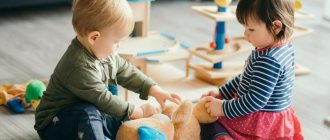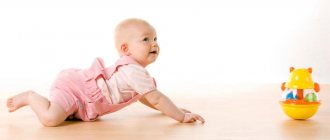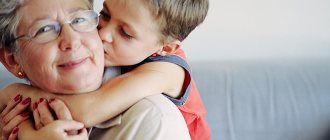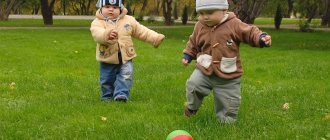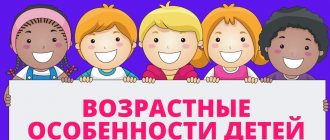Main features of infancy
During the first year of life, children experience various physical changes:
- motor skills are formed (general, fine);
- coordination of movements is normalized;
- the mechanism of muscle tone is improved;
- vision and hearing develop.
By the end of the period, speech and walking are actively developing.
The psychological features of the development of infants include the processes of memory formation and mental function. Some of the conditioned reflexes can be attributed to the manifestation of facial functions. For example, when a baby stops crying when a caring adult appears. The next stage is recognizing objects. After four months, babies begin to perceive melodic sounds. Then the child distinguishes mother from strangers. The older he gets, the wider the range of memorized objects and associations. Closer to one year (9–11 months), at the request of their parents, babies bring or point to a certain thing or toy. By the end of infancy, associative memory develops.
Mental activity is expressed in the desire to achieve a goal at any cost. This is typical for late infancy. Closer to 9 months, babies are able to solve simple spatial problems. This can be observed in the example of a sorter, when a baby selects the right hole for an element of a certain shape. Thinking during this period is flexible, children easily generalize the experience gained and are able to use it in similar situations.
Mental development in the first year of life is considered multichannel. Individual, social, and behavioral characteristics are formed. The participation of an adult and a developmental environment provide the child with full development.
According to Vygotsky, the mental life of an infant is characterized by an absolute lack of differentiation of mental functions. Primitive experiences and instinctive consciousness are formed under the influence of brightly colored emotional processes.
Infancy
The newborn is a transitional stage.
Adaptation with the help of hereditarily fixed mechanisms - the system of food reflexes (food concentration). Unconditioned reflexes – protective and indicative. By the end of the first month, the first conditioned reflexes appear (the baby begins to respond to the feeding position), but in general they develop later.
Mental life. The brain of a newborn continues to develop, it is not fully formed, therefore mental life is connected mainly with the subcortical centers, as well as with an insufficiently mature cortex. The sensations of a newborn are undifferentiated and inextricably fused with emotions, which made it possible for L.S. Vygotsky speaks of “sensory emotional states or emotionally emphasized states of sensations.”
Important events are the emergence of auditory (2–3 weeks) and visual (3–5 weeks) concentration.
Specific social situation of development - helplessness, biological connection with the mother, dependence on an adult.
At about 1 month - the “revitalization complex” - a violent emotional reaction to the appearance of the mother, including a smile, which means the first social need - the need for communication. This marks a new psychological period. Infancy proper begins.
Infancy
Cognitive development of the child: perception - by 4 months. not just sees, but already looks, actively reacts to what he sees, moves.
Perceives the shape of objects, identifies the contour and their other elements, and is able to navigate many parameters of objects (movements, contrasts, etc.).
React to color.
Spatial perception develops, in particular depth perception.
For development, it is necessary to satisfy his need for new impressions, trying to ensure that the environment around him is not monotonous and uninteresting. The baby has a holistic picture of the world.
Movement and actions. Hand movements directed towards an object and feeling an object appear at about 4 months of life.
At 5 – 6 months, an object is grabbed, which requires complex hand-eye coordination – the first purposeful action. Chains of identical, repeating actions unfold, which J. Piaget called circular reactions.
After 7 months, “correlating” actions occur: putting small objects into large ones, opening and closing the lids of boxes.
After 10 months, the first functional actions appear, but they are not yet objective (imitation of adults).
Perception and action make it possible to judge the initial forms of visual-effective thinking.
The cognitive tasks that the child is able to solve become more complex, first only in terms of perception, then using motor activity.
Memory. Recognition comes first. A 4-month-old baby distinguishes a familiar face from an unfamiliar one.
After 8 months, reproduction appears - restoration of the image in memory.
Emotional development. In the first 3 - 4 months. Various emotional states appear: surprise in response to the unexpected (inhibition of movements, decreased heart rate), anxiety in response to physical discomfort (increased movements, increased heart rate, squinting of the eyes, crying), relaxation when a need is satisfied. After 3–4 months, he smiles at acquaintances, but is somewhat lost at the sight of an unfamiliar adult. At 7–8 months, anxiety when strangers appear increases sharply. Around the same time, between 7 and 11 months, the so-called “fear of separation” appears. By the end of 1 year, he strives not only for emotional contacts, but also for joint actions.
Speech. In the first half of the year, speech hearing is formed. Booming. In the second half of the year - babbling, usually combined with expressive gestures. By the end of 1 year, the child understands 10–20 words spoken by adults, and he himself pronounces one or several of his first words, similar in sound to the words of adult speech. With the appearance of the first words, a new stage in the child’s mental development begins.
Characteristics of infancy in different psychological schools
The study of the formation of mental processes in children made it possible to understand the principles and patterns of the development of thinking and perception of the child’s personality. Many concepts and studies formed the basis of modern methods of early development and education.
Cultural-historical theory
In Vygotsky's theory, the infant is viewed as a maximally social being. This is due to his helplessness - without the assistance of his parents, he cannot interact with the world. The basis of mental life in the first year of life is interaction with the mother and other relatives. At the same time, the baby is an active participant in this interaction. It influences the behavior of the mother and other adults in his environment.
Another adherent of cultural-historical theory, Elkonin, proposed considering the baby and his mental development in the “child in society” system. Within its framework, the environment and the baby are not considered separately and in isolation, they are perceived as a single system.
Psychoanalysis
The founder of the theory, Freud, endowed infants with innate drives (instincts). It is their satisfaction, in his opinion, that becomes the main driving stimulus for the behavior of the infant, and subsequently of the adult.
The theory identifies several stages of development that occur sequentially. Children from birth to one and a half years are in the oral stage. This is due to the fact that they get the greatest pleasure from feeding and sucking the breast. Thus, Freud identifies the pleasure center in the mouth.
Erickson complements the theory by considering the entire complex of communication with the mother or an adult replacing her. Kindness, care, and responsiveness to the baby’s needs build his trust in the world. The lack of psychological contact leads to the opposite, wary attitude. Both scenarios affect the future life of the child, and even the adult.
Psychogenetics
Considers mental development and behavior from the point of view of the influence of heredity and environment. One of the leading authors of Piaget's theory assigned the main role in the formation of the psyche to the intellect. The speed and completeness of adaptation to the environment depends on its development. The theory gave the world a twin method for analyzing the influence of genetics and environment on development. Psychogenetics does not take into account personal motives, needs, and feelings.
Behaviorism
The theory considers behavior as an objective phenomenon of mental development. It is formed through the so-called social learning. It is determined by the environment, which is the main source of human mental development. Only behavior is studied, without taking into account emotions and intelligence. The founder of the theory, Watson, placed mental care for the baby at the forefront. He defined it as more important than physical. After all, it is he who shapes character and behavior. By mental development he understood the acquisition of new connections between stimuli and reactions to them, skills, and forms of interaction with the outside world.
Gestalt psychology
The theory believes that the baby's psyche is formed as gestalts mature. They form the constancy and meaningfulness of certain mental processes. Thus, for the first months of life, babies have only a vague, blurry image of an adult caring for them. Closer to six months, a more complete and distinct portrait is formed.
Abstract "Lecture of developmental psychology infancy 0-1"
INFANTRY from 0 months to 1 year.
The first year of a child’s life can be divided into two stages – the neonatal period and the infancy period.
The birth of a child is a difficult turning point in his life. Psychoanalysts say that this is a trauma that a child experiences, and it is so strong that the entire subsequent life of a person passes under the sign of this trauma.
The newborn stage is the time of adaptation of the child to new, extrauterine living conditions, lengthening the period of wakefulness compared to the period of sleep, the formation of the first reactions necessary for mental development - visual and auditory concentration, the appearance of the first combined or conditioned reflexes, for example, to the feeding position.
1. Newborn crisis (from 0 to 2 months).
The neonatal crisis was not discovered, but was the last to be calculated and identified as a special, crisis period in the mental development of the child. A sign of crisis is weight loss in the first days after birth.
Characteristic features of the newborn period
: small difference between sleep and wakefulness, predominance of inhibition over excitation, spontaneous motor activity. Most of the time, the newborn is self-absorbed and wakes up due to mild discomfort caused by feelings of hunger, thirst, cold, etc.
In the first two weeks of life, the only obvious expression of emotion is a reaction of displeasure to discomfort or forced awakening. It is not possible to note positive emotional reactions in the early period of the newborn, since satisfaction of needs leads to the child calming down and falling asleep.
Social situation
the newborn is specific and unique and is determined by two points. On the one hand, this is the child’s complete biological helplessness; he is unable to satisfy a single vital need without an adult. Thus, the baby is the most social creature.
On the other hand, with maximum dependence on adults, the child is still deprived of the basic means of communication in the form of human speech.
The contradiction between maximum sociality and minimal means of communication lies the basis for the entire development of a child in infancy.
Main neoplasm:
- the appearance of a child’s response - a smile to the mother’s (close person’s) appeal;
- revitalization complex.
At the end of the first - beginning of the second month of life, the child begins to clearly distinguish the adult from the environment. From the first days of life, an adult takes proactive initiative towards the child; he attributes to the child the qualities of a subject of communication - he turns to him, asks about something, comments on his own actions. In the first weeks, a child is already able to imitate some of the facial actions that are demonstrated to him (the phenomenon of facial imitation in newborns). Gradually, the child picks up the adult’s communicative messages; in the third or fourth week, the child, in a state of calm wakefulness, can observe the so-called oral attention
in response to the gentle voice and smile of an adult addressed to him, the child freezes, his lips slightly stretch forward, and
eye contact
.
At the age of 4-5 weeks, this is followed by an attempt to smile and, finally, a real, so-called social smile, or communication smile
. During this period, mutual emotional identification of the adult and the child is formed. This “merging” forms the basis for future attachment relationships and lays a feeling of trust, first in the mother, and later in the person in general.
So, the most important psychological new development of the neonatal crisis period is considered to be the emergence of the child’s response - a smile to the mother’s appeal. This marks the beginning of the child’s individual mental life. During this newborn period, life is individual
an existence separate from the mother’s body, but in close interaction with her.
In addition, it becomes mental
life, because, according to Vygotsky, only mental life can be part of the social life of the people around the child.
In the following weeks, a revitalization complex develops, which serves as the boundary of the critical period of the newborn and an indicator of the transition to infancy as a period of stable development.
The revival complex is a special emotional-motor reaction addressed to an adult. Starting with freezing, focusing on the adult’s face and smiling, in the following weeks this reaction acquires a truly comprehensive complex character. At 8 weeks, the components of the joyful animation reaction are accompanied by a loud short sigh; at 10-12 weeks it includes a series of deep sighs, throwing up of arms, moving legs, joyful squealing, and various vocalizations (humming, screaming). The emergence of a child’s initiative in communication is expressed in his use of screaming and crying to attract attention to himself. The timeliness of the appearance and degree of severity of the revitalization complex is the main criterion for the normality of a child’s mental development in the first half of life. The revitalization complex appears earlier in those children whose mothers not only satisfy the vital needs of the child (feed on time, change diapers, etc.), but also communicate and play with him.
In the first two months, the formation of conditioned reflexes occurs in all analytical systems:
- reflex to position during feeding (reaction to feeding position);
- the orienting reflex manifests itself:
1) in visual concentration (at 3-5 weeks);
2) in auditory concentration (at 2-3 weeks);
3) to a person’s voice (at 3-4 weeks);
- reflex to sleep and wakefulness.
The time spent sleeping gradually decreases and the duration of wakefulness increases. Each of the stages of change in the nature of sleep coincides in ontogenesis with the stages of development of thinking. Active intellectual life is decisive in the development of functional asymmetry of the brain.
2. Infancy (from 2 months to 1 year).
The crisis period of the newborn ends, and the period of stable development - infancy - begins.
The leading type of activity
is
direct emotional communication, or situational and personal communication with an adult. The object of this activity is another person. The main content of communication between an adult and a child is the exchange of expressions of attention, joy, interest and pleasure through facial expressions, gestures, bodily contact (stroking, braking, hugging), sounds, words. Dependence on an adult is comprehensive. For example, cognitive: all cognitive processes are realized in relationships with the mother and with the help of her.
Neoplasms of age.
The most important acquisitions are walking and the first words.
By the end of the first year, the child acquires the ability to move independently: crawling appears, then an upright gait (walking). The world opens up before him from a new perspective. Walking makes it possible to separate the child from the adult, turning the child into a subject of action.
At the end of the first year, there is a fragmentation of the emotional community with the native adult and a restructuring of the social situation of development.
The period from birth to one year is the pre-speech, preparatory stage of speech development. Speech hearing and breathing, articulation of sounds and intonation, and speech imitation are formed. We can highlight the development of understanding of someone else's speech and the development of the pronunciation side of speech.
Voice manifestations
go through a series of successive stages: screaming, hooting, humming, babbling. The main vocal reaction of a newborn is screaming (crying) as an expression of negative emotions. Starting from the eighth week, the types of crying change. The cry has a different character depending on what causes it (hunger, pain, cessation of communication) and what the child wants to achieve.
At the age of 1.5 to 4 months, short sounds are distinguished that have the character of a calm narrative - humming.
From 4 to 6 months, the child makes prolonged vowel sounds (“maaa”, “baaaa”) - this is true, or melodious,
humming.
At 6-7 months, babbling appears - repeated syllables, chains of syllables in response to the vocal communication of an adult, when the child looks closely at the articulation of the adult, listens to him and to himself.
By 9 months in the context of communication with an adult
there comes a “blooming” of babble, its enrichment with new sounds, intonations, greetings and exclamations.
Communication with adults is equipped with new means. autonomous speech develops
. The child begins to use stable sound combinations that are intonationally expressive and equal in meaning to a sentence, the meaning of which can only be understood by focusing on the current situation as a whole. The baby says: “Give!”, and, taking into account his facial expressions, gaze, and the direction of his hands, the mother “reads” the child’s demand. It could be: “I want to get my favorite cup as soon as possible” or “Take me in your arms.”
The other side of speech development is passive mastery of words, understanding
speech addressed to him.
Passive speech is ahead of active speech in its development
. If in the first months of life the speech of an adult is perceived by the child as a transmission of an emotional state, then in the second half of the year the conditions arise for a situational understanding of the speech addressed to him. At 9 months, the child demonstrates his understanding of verbal instructions: he wraps his arms around his neck when asked to “Hug Mommy,” etc.
Also during this period, the child masters voluntary actions with objects in the surrounding world (structure of objective action).
Object activity is associated with the development of movements in a child. There is a pattern in the sequence of movement development.
1. Moving eye. The phenomenon of “newborn eyes” is known - they can look in different directions. By the end of the second month, these movements are refined, and the child is able to visually concentrate on an object. By the third month, eye movements are developed almost the same as in an adult, and binocular vision is formed.
2. Expressive movements (revival complex).
3. Moving in space is a prerequisite for mastering activities with objects. The child consistently learns to roll over, raise his head, sit down, crawl, stand on his feet, and take his first steps. All this - at different times, and the timing is influenced by the parents' strategy. Mastering each new movement opens up new boundaries of space for the child.
4. Crawling. Sometimes skips this stage.
5. Grasping. By the end of the first half of the year, this movement turns from accidental grabbing of the toy into a deliberate one.
6. Manipulation of an object. It differs from “real” actions in that the item is not used for its intended purpose.
7. Pointing gesture.
8. Arbitrariness of movements and gestures, controllability. This is the basis for new formation – objective activity.
As soon as a child learns to walk, the boundaries of the accessible world expand. Consequently, the rivers are freed and the child gets the opportunity to act with things.
Subject activity
- this is activity with objects according to their purpose. But the method of action is not “written” on objects; it cannot be discovered by the child independently. The child must learn this from adults. Gradually the child masters human action.
He masters:
· purpose of the item;
· ways of working with objects;
· technique of performing actions.
Toys are of great importance in mastering objective activities. Their purpose is in accordance with the leading activities (first - in indicative behavior, then - in communication with adults; then - in objective activity).
Mental development.
In the first half of life, the child’s perception improves at the most rapid pace, and sensory systems intensively develop. The pattern of accelerated development of sensory skills compared to motor skills is clearly evident.
Already by 3-4 months, the visual and auditory abilities of infants do not differ from those of adults. By this age, the child, as a rule, freely follows objects moving in any direction, at any distance and at any speed; able to concentrate for a long time when looking; makes proactive eye movements (actively looking for an object to look at); correctly connects auditory and visual impressions (localizes sound in space - turns his head and looks for the source of the sound with his eyes).
In the second half of the year, special indicative actions gradually take shape, aimed at examining the surrounding space and objects. In a state of calm wakefulness, the child shows interest in toys; he not only looks at them for a long time, but also brings his hands closer to them, clasps them, and pulls them into his mouth. Tactile sensitivity develops.
According to Piaget, a child under one year of age is in the 1st period of mental development - sensorimotor.
Children at this time have not yet mastered language and they do not have mental images for words. Their knowledge about people and surrounding objects is based on information received from their own senses and random movements. The sensorimotor period goes through 6 stages, 4 of which are up to a year.
1. Reflex exercise.
Children “practice” all the skills they have at a given stage of development. These are unconditioned reflexes: sucking, grasping, crying. In addition, newborns can also look and listen.
2. Primary circular reactions
(1 – 4 months of life). The child begins to adapt to his environment using accommodation (adjusting old patterns to new information).
3. Secondary circular reactions
(4 – 8 months). Children voluntarily repeat those forms of behavior that give them pleasure; They develop the ability to perceive object permanence. This quality is associated with the appearance of the first fears at 7-8 months (fear of the “stranger”), and the perception of the permanence of objects forms the basis of attachment to people significant to the child.
4. Coordination of secondary circuits
(8 – 12 months). There is further development of all the mentioned abilities of the child. Babies show the first signs of the ability to anticipate events (for example, they cry at the sight of iodine).
Basic need of age.
The basic need of age is the need for safety and security. She must be fundamentally satisfied. This is the main function of an adult. If a child feels safe, then he is open to the world around him, he will trust it and explore it more boldly. If not, it limits interaction with the world to a closed situation. E. Erikson says that at a young age a person develops a feeling of trust or distrust in the world around him (people, things, phenomena), which the person will carry throughout his life. A feeling of alienation occurs when there is a lack of attention, love, affection, or when children are abused.
At the same age, a feeling of attachment is formed.
There are 3 phases in the process of forming a child’s attachment:
1) the baby seeks intimacy with any person;
2) learns to distinguish familiar people from unfamiliar ones;
3) a feeling of attachment arises for those people who are especially significant for the child. Social communication and a feeling of comfort contribute to the formation of children's attachment more than timely feeding, as they give this feeling a purely human character.
The second half of the stable period is characterized by an expansion of the boundaries of communication. The unity of the adult and the child is broken, two appear. Consequently, the social situation changes. Its change is the essence of the crisis of one year.
Crisis of one year.
An increase in motor capabilities (crawling, walking) leads to an increase in the availability of many things, often unsafe for the child. There is a forced ban on the part of the parents .
Constantly facing opposition from an adult in realizing some of his aspirations, the child begins to understand that his desires do not always coincide with the desires and feelings of another person. From a calm and compliant child turns into an incredibly active, willful, trying to achieve his desire.
Vygotsky considered the emergence of special affective states – hypobulic reactions
, proceeding according to the type of emotional explosion.
The child demands what he wants and encounters resistance from adults; he is disappointed, bursts into tears, and throws himself on the floor. The child discovers his own desire and becomes its subject; I am the willing one
appears .
The one-year crisis is characterized by the development of speech action. The baby's body was regulated by a biological system associated with biorhythms. Now she came into conflict with a verbal situation based on self-order or orders from adults. Thus, a child aged about one year finds himself without a system at all that allows him to reliably navigate the world around him. Biological rhythms are greatly deformed, and speech rhythms are not so formed that the child can freely control his behavior.
The crisis is characterized by a general regression of the child’s activity, a kind of reverse development. Emotionally manifests itself in affectivity. Emotions are primitive. In this case, various violations are observed:
· disruption of all biorhythmic processes (sleep – wakefulness);
· violation of satisfaction of all vital needs (for example, hunger);
· emotional abnormalities (sullenness, tearfulness, touchiness).
The crisis is not an acute one.
Understanding parents try to direct the activity of a child striving for independence in the right direction. Everything shouldn’t just come down to “don’ts.” The space of the house must be clearly divided into permitted and prohibited. Whenever possible, prohibitions should be replaced with more flexible behavior: inspect the house for its “friendliness” towards the child; teach your child how to handle things correctly; be able to offer a choice, an attractive replacement for a dangerous item.
Structure and dynamics of leading activity in infancy
The leading activity of the first half of infancy is emotional communication with adults. From the age of three months, the baby looks for it and attracts the mother’s attention.
In the second half, the child becomes more mobile. He can roll over on his own, learns to grab, sit, and crawl. He is increasingly focused on studying the world around him. Manipulation with objects closer to 9 months becomes the basis of his activity. He cannot yet use them for their intended purpose, but he finds his own use.
To move on to objective activities (using things for their intended purpose), he needs the help of adults. Changing the type of activity closer to the year means the end of the infancy period and the beginning of the early childhood stage.
Communication between infants and adults
The first year of life, the child is completely dependent on the adults around him. His basic need is a feeling of security. It is this feeling that makes the baby understand that everything is fine with him, there are no threats. If this need is fully satisfied, he is open to the world and ready for full contact with it.
In psychology, the concept of “mother-child dyad” or “Prime-we” was introduced for the stage of infancy. It determines the mental community of the baby and the adult caring for him. During this period, the child is not aware of himself, is unable not only to distinguish his Self, but also perceives his own limbs as foreign objects. Therefore, the adult becomes the center of interaction with the child and the child with the world.
The first half of the year is characterized by situational and personal communication between the baby and mother. It manifests itself as a revitalization complex that marks the end of the newborn crisis. It is characterized by focusing on the mother's face, a welcoming smile, and active movements that attract the attention of an adult. This is purely emotional communication. The mother’s kindness towards the baby during this period is the key to normal mental and cognitive development in the future.
The second half of the period is characterized by situational business communication. It lays the foundations for objective activity. The child enters this stage after he learns to grasp objects. In the process of contact with an adult, he uses not only facial expressions and sounds, but also gestures, postures, and various things. He can show, bring closer, remove, throw, demand any toy. Babies begin to feel the need for joint activities with their mother.
During this period, attachment formation occurs. It is the key to the child’s psychological health. There are three stages of its formation:
- The infant seeks contact and closeness with any adult in sight.
- Begins to distinguish “us” from “strangers”.
- Attachment to the most significant adults is formed.
It is full communication with the baby that allows him to successfully develop physically, mentally, mentally.
Psychological characteristics of the newborn period
The child has sensitivity: distinguishes salty, bitter, sweet taste; reacts to sound stimuli. Important events in the mental life of a child - the emergence of auditory and visual concentration
.
Auditory concentration appears at 2-3 weeks. A sharp sound, for example, a door slamming, causes a cessation of movements, the child freezes and becomes silent. Later, at 3-4 weeks, the same reaction occurs to a person’s voice. At this time, the child not only focuses on the sound, but also turns his head towards its source. Visual concentration, which appears at 3-5 weeks, is externally manifested in the same way: the child freezes and holds his gaze (of course, not for long) on a bright object. A newborn, having acquired the ability to respond to the voice of the mother caring for him, to see her face, establishes emotional connections with her. At about 1 month, the baby, seeing his mother, fixes his gaze on her face, throws up his arms, quickly moves his legs, makes loud noises and begins to smile. This violent emotional reaction has been called the “animation complex.”
The animation complex, which includes a truly human characteristic - a smile - marks the emergence of the first social need - the need for communication. And the development of a child’s need for communication means that in his mental development he moves from newbornness to infancy itself.
Main neoplasms of infancy
The main acquisitions of infancy are the ability to walk and the first consciously spoken words. The ability to move without the help of an adult takes the child to a new stage of cognitive activity. In psychology, he is considered as a subject capable of performing independent actions. This is due to the emergence of motivating needs. They mean emotionally charged images of objects that appear in the baby’s memory, with which some of the needs are associated. That is, although the child will show or grab his sippy cup or cup when drinking.
By the end of infancy, children master voluntary actions with objects. From manipulation they gradually move to substantive activity.
But for this successful transition you need the help of an adult. Only by imitating their parents will the child understand how to use this or that thing for its intended purpose.
By one year the child will have mastered:
- the purpose of simple objects (spoon, plate, chair);
- ways of acting with them (eating with a spoon, sitting on a chair);
- technique of performing the action (you need to take a spoon in your hand and try to scoop up food).
A child around one year of age becomes emotionally separated from the mother or other significant adult. Thanks to the emergence of speech, the social situation changes and new opportunities for communication appear.
A new development in children aged about one year is the transition from passive speech through the autonomous to active phase. If previously the child only understood intonations and part of the words, now he is developing his own “bird” language. He is understandable only to the closest people who come into contact with him on a daily basis.
Autonomous speech is characterized by:
- The ambiguity of the same words depends a lot on the emotional coloring and the situation.
- The discrepancy with normal speech is not phonetic or articulatory.
- It is difficult to find a connection between spoken words. The phrases are more like emotionally charged exclamations.
Many psychologists associate the appearance of autonomous speech with the beginning of the crisis of the first year of life. And the transition from it to the usual one is with its completion.
Newborn crisis
The process of birth is a difficult, turning point in the life of a child. Psychologists call this period the neonatal crisis.
Causes of the neonatal crisis: - Physiological (being born, the child is physically separated from the mother. He finds himself in completely different conditions: cold, bright light, an air environment that requires a different type of breathing, the need to change the type of nutrition). — Psychological (the psyche of a newborn child is a set of innate unconditioned reflexes that help the child in the first hours of his life). What unconditioned reflexes does a newborn have? These are, first of all, breathing and sucking reflexes, protective and orientation reflexes. Some reflexes are atavistic (“catching”) - they are received from animal ancestors, are useless for the child and soon disappear. The child sleeps most of the time.
Crisis of one year
The second transitional moment in the development of the child’s psyche. The basis of the crisis is the conflict between the skills he has acquired (walking, manipulating objects), the desire to show independence and the restrictions imposed by adults. On the one hand, he wants to do everything himself, but they don’t allow him, on the other hand, he is just developing his speech and fully communicating, he cannot defend his rights, and he cannot do without the help of an adult.
The crisis is characterized by:
- violation of sleep and eating patterns;
- mood swings, bright outbursts of emotions;
- negative reaction to any ban;
- increased need to be near a significant adult.
During this period, it is important for parents to develop a general strategy of behavior and correctly set personal boundaries and prohibitions. It is important not to punish the baby, since he still won’t understand the reason, not to scream, not to scold him.
Early age (from 1 year to 3 years)
The next stage - psychological separation from the mother - begins in early childhood. This is due to the fact that the child not only develops new physical capabilities, but also intensively develops psychological functions, and by the end of the period, the initial foundations (rudiments) of self-awareness appear.
Development of mental functions. Sensitive period for speech acquisition.
Speech. By the age of 3, a child’s speech acquires a substantive meaning and, in connection with this, substantive generalizations appear. Active and passive vocabulary is growing rapidly. By the age of 3, a child understands almost everything. Speaks 1000 – 1500 words.
Perception. At an early age, other mental functions develop - perception, thinking, memory, attention. Perception dominates.
This means a certain dependence of other mental processes on it. This manifests itself - young children are maximally connected to the current situation. Their behavior is spontaneous and impulsive; nothing that lies outside the visual situation attracts them.
Until the age of 2, a child cannot act at all without relying on perception.
Elementary forms of imagination. A small child is not capable of inventing something or lying.
Perception is affectively colored - impulsive behavior. Observed objects really “attract” the child, causing him to have a strong emotional reaction. The affective nature of perception leads to sensorimotor unity. The child sees a thing, he is attracted to it, and thanks to this, impulsive behavior begins to unfold - to get it, to do something with it.
Memory. Basically, this is recognition, there is no reliance on past experience.
Actions and thinking. Thinking in this age period is usually called visual-effective. It is based on the perceptions and actions carried out by the child. And although at approximately 2 years of age the child develops an internal plan of action, throughout early childhood objective activity remains an important basis and source of intellectual development. In joint activities with an adult, the child learns ways of acting with a variety of objects.
Thinking initially manifests itself in the very process of practical activity, therefore, according to domestic psychologists, it lags behind it in terms of the general level of development and the composition of operations. The objective actions themselves are also improved. The mastered actions are transferred to other conditions.
The leading activity during this period is object-manipulative. The child does not play, but manipulates objects, including toys, focusing on the actions with them. However, at the end of early childhood, play with a plot still appears in its original forms. This is the so-called director's game, in which the objects used by the child are endowed with playful meaning. For the development of play, the appearance of symbolic or substitutive actions is important.
Emotional development. The development of mental functions is inseparable from the development of the emotional-need sphere of the child. The dominant perception at an early age is affectively colored. The child reacts emotionally only to what he directly perceives.
The child’s desires are unstable and quickly passing, he cannot control and restrain them; They are limited only by punishments and rewards from adults. All desires have equal strength: in early childhood there is no subordination of motives. The child still cannot choose or settle on one thing - he is not able to make a decision.
The development of the emotional-need sphere depends on the nature of the child’s communication with adults and peers.
In communication with close adults who help the child explore the world of “adult” objects, the motives of cooperation predominate, although purely emotional communication, which is necessary at all age stages, also remains.
A young child, when communicating with children, always proceeds from his own desires, completely disregarding the desires of others. Egocentrism. Doesn't know how to empathize. Early childhood is characterized by vivid emotional reactions associated with the child’s immediate desires.
At the end of this period, when approaching the 3-year crisis, affective reactions to the difficulties faced by the child are observed. A young child is easily distracted. If he is really upset, it is enough for an adult to show him a favorite or a new toy, offer to do something interesting with him - and the child, for whom one desire is easily replaced by another, instantly switches and is happy to do a new activity.
The development of the child’s emotional-need sphere is closely related to the emerging self-awareness at this time. At about 2 years old, the child begins to recognize himself in the mirror. Self-recognition is the simplest, primary form of self-awareness. The consciousness of “I”, “I am good”, “I myself” and the emergence of personal actions propel the child to a new level of development. The transition period begins - a crisis of 3 years.
